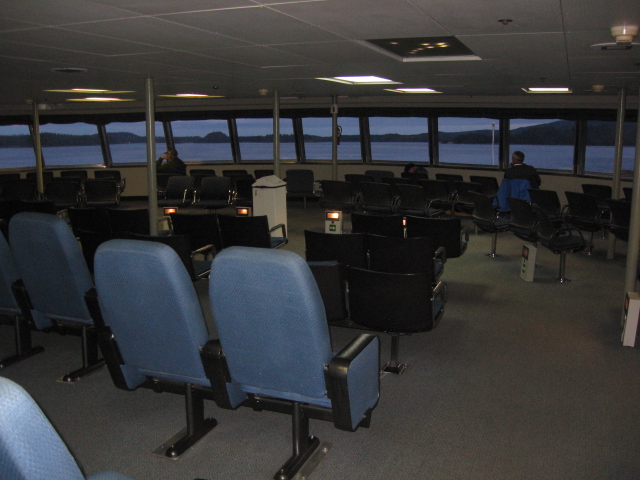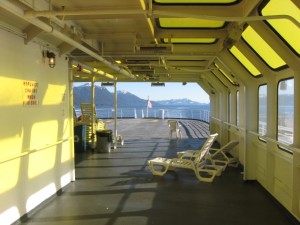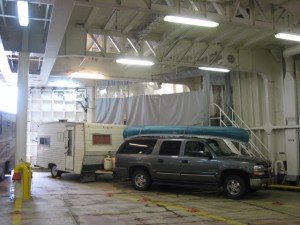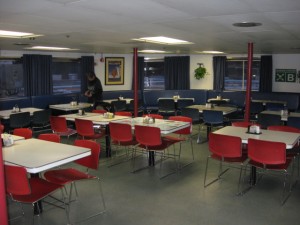
Alaska Ferry Trip Day One
 I have spent the past four days travelling on the Alaska ferry system from Prince Rupert, British Columbia to Skagway, Alaska. The Alaska ferry system is officially known as the Alaska Marine Highway.
I have spent the past four days travelling on the Alaska ferry system from Prince Rupert, British Columbia to Skagway, Alaska. The Alaska ferry system is officially known as the Alaska Marine Highway.
The ship was the M.V Taku, which is named after the Taku Glacier. It was built in Seattle, Washington in 1963. It is 352 feet (107.3 metres) long and has a gross tonnage of 2,642. Two 4,000 HP engines drive the ship at a speed of 16.5 knots. The fuel consumption is 300 gallons (1135.6 liters) per hour of diesel fuel. The engines were replaced in the 1980’s. The second engine is not a spare; both engines run simultaneously. If one engine were to brake down, the ship would still precede but at a much reduced rate of less than half of the normal speed.

 The Taku is a great ship. It has a very nice observation lounge across the whole width of the ship at the front. The bridge, where the Captain pilots the ship is on the deck above. The Taku also has a movie or TV lounge, an open-air solarium on the top which would be great on warm days, a cafeteria-style restaurant, lockers, a gift shop and a bar.
The Taku is a great ship. It has a very nice observation lounge across the whole width of the ship at the front. The bridge, where the Captain pilots the ship is on the deck above. The Taku also has a movie or TV lounge, an open-air solarium on the top which would be great on warm days, a cafeteria-style restaurant, lockers, a gift shop and a bar.
As I was going to be on the ship for such a length of time, I rented a small cabin which was a bargain at $144 for an outside cabin with a window or $20 less for an inside cabin. The Taku has nine four-berth cabins, 33 two-birth and two wheelchair accessible cabins. My cabin had a bunk-bed, a window, and a private bath with sink, toilet and shower. The shower was great with lots of hot water. It is also a good place to store your belongs while you are walking around the ship. Access to the vehicle deck is not permitted when the ship is in motion.
The ship holds 35,000 gallons of fresh water. Fresh water is used for the kitchen, sinks and showers. Salt water is pumped in for the toilets. The engines are water cooled with salt water. There is a sewage treatment plant on board and sewage is treated with chemicals and then released into the sea, much the same as the sewer system for a town.

 The cargo area can accommodate 1,380 feet of vehicle space in several rows. Besides private vehicles, cargo trailers of goods are also carried to supply stores such as Walmart and others in Juneau. Trailers of food are carried for grocery stores. The refrigerated trailers are plugged in during the trip to keep the food cold.
The cargo area can accommodate 1,380 feet of vehicle space in several rows. Besides private vehicles, cargo trailers of goods are also carried to supply stores such as Walmart and others in Juneau. Trailers of food are carried for grocery stores. The refrigerated trailers are plugged in during the trip to keep the food cold.
The trip for a passenger and the rental of a cabin for two people is a bargain, but bringing a long vehicle such as my truck with trailer can get expensive. My total for myself, the truck, trailer and cabin rental was over $1,200. This seems like a lot but I think if I had driven to the Yukon, it would have cost me just as much or more for gasoline and hotels. And I did not have to drive or take any risks with weather or traffic along the way. It was a good deal.
There were very few passengers. I think there were more crew than passengers. They probably lost money on this trip. I was told that the last week of February has the lowest amount of passengers. Next week, it will start to pick up again and during the summer months the ship is packed. It can carry a maximum of 370 passengers but I think there were only about 20 on this trip. It was nice because it was not crowded and you could get a seat in the front row of the observation lounge any time you wanted. In the summer, when the ship is packed, you will be lucky to get a seat there. Also in summer, you will definitely require a reservation. Especially if you at taking a vehicle or wanting a cabin.
The first day was cloudy and gloomy and I did not get any nice photos. Still, it beats driving for less than I would have paid for gas and a hotel. Day two and three were glorious and sunny and the scenery was magnificent. I got some nice photos. Check back in a day or two for part two of this story.

